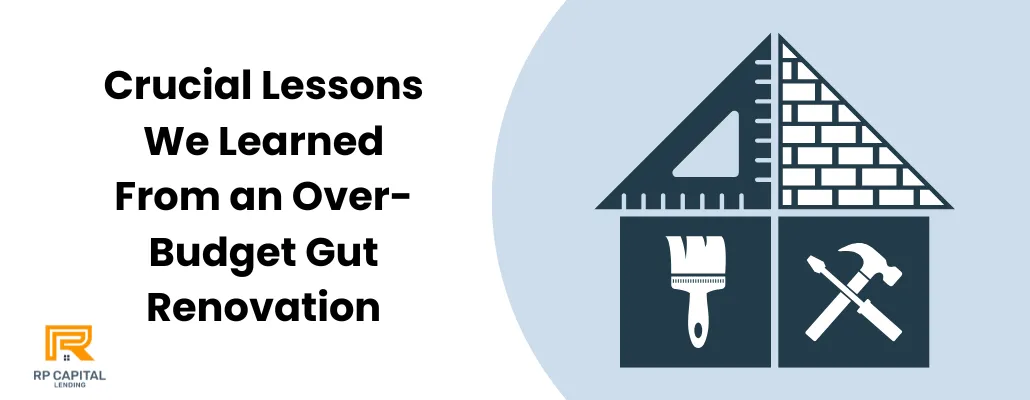Blog

4 Game-Changing Lessons From a Full Gut Renovation
Real estate rehabs are rewarding but only if you do them right.
At RP Capital Lending, we’ve seen it all from investors doubling their ROI to others barely breaking even despite months of work. One of the most common hurdles we see? Renovations that go way over budget.
Recently, we analyzed a project that involved a full gut renovation. While the investor did manage to sell the property and walk away with a profit, it was a very close call. Below, we’re breaking down this case and sharing the four key lessons you should take away before tackling your next big rehab.
Let’s dive in.
Project Overview & Financial Summary
Let’s set the stage. We took on a full gut-renovation of a property in rough shape the kind you walk into and immediately know it’s going to be a challenge. We’re talking mold, rotted flooring, structural issues, and a host of surprises hidden behind every wall.
Total Cost: $332,457 (including purchase, renovation, and holding costs)
Sale Price: $351,000
Net Profit: ~$18,500
While we technically ended in the black, this was far from our usual profit margin. The thin spread between cost and return underscored the importance of budgeting smarter and planning for worst-case scenarios. It also reminded us of the importance of time management. The longer the project runs, the more holding and opportunity costs you incur.
Pro Tip: Clearly define your investment goals early. Are you flipping, renting, or building equity? Each goal demands a different budgeting approach and affects your timeline and exit strategy.
Lesson 1: Budget for the Worst-Case Scenario
This project reinforced one of the most important truths in real estate: hope for the best, but always plan for the worst.
We encountered:
Hidden plumbing and electrical issues
Pest infestations
Foundation concerns
Permit delays
Material shortages and price hikes
These problems inflated our budget and delayed our timeline. If we hadn’t built in a financial cushion, the entire deal could’ve fallen apart.
What you can do:
Add a 15-20% contingency buffer to every renovation budget
Create a tiered budget plan:
Base Budget: Ideal costs
Stretch Budget: Moderate risks
Max Budget: Worst-case ceiling
Maintain a renovation-specific reserve account
Stay updated on construction regulations, labor availability, and materials pricing
Lesson 2: Let Data Guide Your Model
Your instincts matter, but in a tight-margin business like real estate, data is your safety net.
Before purchasing any property, run:
Comparative Market Analysis (CMA)
Contractor bid comparisons
Market demand and trends
Neighborhood data (schools, safety, development)
Days on Market (DOM) stats
We recommend using tools like ROI calculators and deal analyzers to simulate costs, returns, and timelines.
Extra Tip: Conduct sensitivity analysis. What if renovation costs rise 10%? What if your timeline stretches by a month? Mapping out those scenarios helps you protect profits.
Don’t forget to monitor interest rates too. Higher borrowing costs shrink your net gains. And remember, macro trends like gentrification or economic slowdown can impact resale price and timing.
Lesson 3: Choose Partners Wisely
Your team is your biggest asset or your biggest liability.
In this project, better contractor vetting and clearer scope documents could have avoided many delays. Strong partnerships help you execute faster, negotiate better, and avoid common traps.
Tips for choosing the right people:
Always check licenses, insurance, and past work
Draft contracts with timelines and performance clauses
Communicate expectations early and often
Use tools like Trello, Asana, or Buildertrend to manage timelines
Build long-term vendor relationships based on trust
Leverage referrals from other investors and local real estate groups
Bonus Insight: Reward excellence. If a contractor exceeds expectations, pay them on time, refer them to others, and use them again. The stronger your network, the stronger your next deal.
Lesson 4: Make Every Project a Learning Opportunity
Every renovation, good or bad, is a stepping stone to becoming a smarter investor.
After each project, document:
Budget vs actual costs
Planned vs actual timelines
What went wrong, what went right
Product feedback from suppliers
Final ROI and what could improve
Maintain a digital or physical project journal. It becomes your personal playbook, refined with every deal.
Also, share your knowledge. Whether in investor meetups, Facebook groups, or podcasts, learning from and teaching others keeps your edge sharp and your community strong.
Train your team to embrace this mindset too. Encourage open feedback from contractors, project managers, and even buyers or tenants. A culture of continuous learning leads to long-term gains.
Final Thoughts
A gut renovation can be your best investment or your biggest headache. The difference lies in:
Building in a strong contingency
Letting data, not emotion, guide your choices
Surrounding yourself with reliable partners
Using every project as a learning tool
Staying focused on systems, not one-off wins
At RP Capital Lending, we understand every angle of real estate investing because we’ve lived it ourselves. Whether you need funding, guidance, or a partner who gets it, we’re here for you.
📞 Let’s connect and help make your next project your best one yet.
RP Capital Lending is a d.b.a of RP Capital Partners Inc (NMLS # 2469193) | Privacy Policy
Copyright © 2022. All Rights Reserved.
Disclaimer: Loans only apply to non-owner occupied properties. Rates, terms and conditions offered only to qualified borrowers, may vary upon loan product, deal structure, other applicable considerations, and are subject to change at any time without notice.

